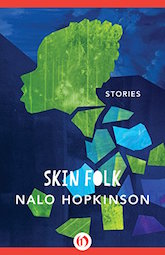Nalo Hopkinson’s “Fisherman” was the first trans story I ever read where the trans character wasn’t an extraterrestrial or the product of futuristic biotechnology. The story made a significant impression on me, and so it occurred to me to take a look at Skin Folk, the collection where it first appeared.
Nalo Hopkinson is a cis queer Afro-Caribbean writer of speculative fiction who has lived in Jamaica, Guyana, Trinidad, Canada, and is currently living on the West Coast of the U.S. Besides many novels, she has had multiple short story collections published, most recently Falling in Love with Hominids—while this book, published in 2015, is too recent for me to include in this column, I would like to warmly recommend it. Skin Folk was Hopkinson’s first collection, yet it doesn’t come across as immature—the stories are confident, written with a strong and determined voice.
Five stories of the fifteen included in Skin Folk had been unpublished prior to the collection—including the later quite widely anthologized “Fisherman.” This is a slightly higher ratio of unpublished pieces than is common in single-author collections, but the original stories are not in any way weaker than the reprints. To the contrary, they are experimental and daring… As I often find myself saying, this phenomenon demonstrates that markets used to be much less open to unconventional work by marginalized (often multiply marginalized) authors.
Buy the Book


Skin Folk: Stories
By and large, the pieces in this collection are confidently boundary-pushing, and come across as fresh even today. Many engage with Caribbean themes and settings, with or migrant experiences. Hopkinson combines a variety of Caribbean and Anglo dialects of English in the telling, and offers perspectives which remain severely underrepresented in English-language speculative fiction almost two decades later. (I would like to refer the interested reader to Tobias Buckell’s bibliography of Caribbean SFF.) Queerness is occasionally the main theme, but it also appears in the background of some stories, matter-of-factly. Here I’m mostly going to discuss the queer aspects of these tales, but I could write an entire set of essays approaching this multifaceted work from different angles—it draws one in with its complexity.
“Fisherman” is the most unambiguously queer of these stories, and also probably the least speculative—the author mentions in the brief preamble that it only has a very small speculative element involving mutant fish. The story follows K.C., a young Black fisherman, who finally works up his courage to become a client of a sex worker, like his fellow fishermen regularly do. We follow the events from his perspective (and through his dialect), and we find out that he’s not like the others. K.C. was assigned female at birth, and his fellows all know of this. He has conflicts not only about his own body, but also his place in society—and yet, the story has a positive, hopeful outcome. It also offers a subversion of the naked trans reveal trope: the careful reader can come to the realization that K.C. is trans before his sex partner does, and the story begs for at least one reread.
Another piece in the collection, “Ganger (Ball Lightning)” plays with gender and eroticism in an entirely different way. Here, a Black man and a woman are trying to add novelty into their longstanding relationship, to keep their routine from growing stale. They decide to experiment with science fictional skin suits that amplify tactile sensations. Once the suits have molded to their bodies, they swap them out, thus enabling each of them to briefly experience the sensations of having the other’s body shape, including genitals. This is very much a story of cis people experimenting and finding they got more than what they bargained for—when they don’t follow the instructions, the story takes a turn into horror. I had a small gripe here, in that the story briefly plays into the potential monstrosity of a being with two sets of genitals, but only briefly. There is plenty else to appreciate, including the very honest and startled dysphoria of a cis person not dealing well with unmatching genitals (!), and also the engagement with race issues. The man of the couple, Cleve, confesses that he is apprehensive about dirty sex talk because he is a large Black man, and doesn’t want to appear threatening: “I ‘fraid to use harsh words, Issy, you know that. Look at the size of me, the blackness of me. You know what it is to see people cringe for fear when you shout?”
Sometimes queerness only appears tangentially. In “Something to Hitch Meat To,” the protagonist Artho works as a graphic designer for a porn company, and many of the employees are either stated to be queer or are queer-coded in some way—while they produce porn aimed at the straight and white gaze. Artho feels conflicted, and the plot examines his internal turmoil as he comes to meet a spiritual being and acquires unusual abilities.
Many of the stories have little to do with queerness, or even sexuality. For example, the strikingly experimental “Under Glass” presents a postapocalyptic world saturated with glass splinters, and a girl whose electronic device is a gateway to another life. If you’ve ever found yourself stunned by just how much damage a tiny piece of glass can wreak, you will either nod along in agreement or have terrible nightmares after reading this piece; it has some of the most memorable worldbuilding I’ve come across recently.
Hopkinson’s work also explores the edges of sexual behavior in general, sometimes with a generous helping of horror. In “The Glass Bottle Trick,” a woman finds out the terrible secrets of her husband in a story that combines Caribbean folklore and the European Bluebeard legend. But possibly the most chilling story in this vein is “Snake,” about child abuse from the point of view of the abuser. While mundane and magical forces come together to rescue the abuser’s latest victim, we’re still subjected to his thought processes and his scheme to kidnap a young girl.
Overall, this collection feels strikingly contemporary, even though it’s almost two decades old at this point. It’s diverse in multiple respects, unapologetically queer, and body-focused in a way that ranges from the sensual to the sexual to the utterly terrifying. I strongly suggest you pick it up, and if you’d like to support Nalo Hopkinson in creating more fiction (as well as other things), she has a Patreon, too. Next time, we’ll be back to novels, and the far reaches of outer space!
Bogi Takács is a Hungarian Jewish agender trans person (e/em/eir/emself or singular they pronouns) currently living in the US with eir family and a congregation of books. Bogi writes, reviews and edits speculative fiction, and is currently a finalist for the Hugo, Lambda and Locus awards. You can find em at Bogi Reads the World, and on Twitter and Patreon as @bogiperson.










